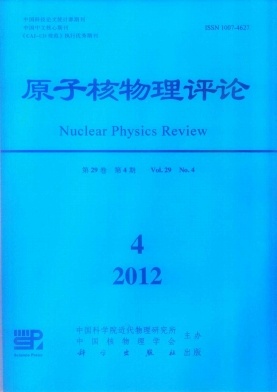Progress in Study of Dineutron Cluster Structure
doi: 10.11804/NuclPhysRev.29.04.317
- Received Date: 1900-01-01
- Rev Recd Date: 1900-01-01
- Publish Date: 2012-12-20
-
Key words:
- dineutron /
- pairing correlation /
- direct nuclear reaction /
- neutron cross talk
Abstract: This article outlines the progress in the study of the dineutron structure in various systems. Systematic theoretical investigations reveal that dineutron structure is a general phenomenon appeared at nucleus surface and in low density nuclear matter. But the underline mechanism of forming dineutron clusters at the surface of heavier nuclei is quite different to that for light halo nuclei or at the low density nuclear matter, with the former being basically due to the so called “size effect” and the latter due to the enhanced pairing interaction. It is also realized that the RMS radii of the dineutron cluster at the surface of light halo nuclei or heavier finite nuclei varies with the distance from the center of nuclei (or background density) and may attain a minimum of about 2~3 fm, whereas that in the low density nuclear matter may only attain about 5 fm. From experimental side, Coulomb excitation caused by heavy targets provides a good way to extract the mean distance from the center of the neutron pair to the center of nucleus. But up to now it is still difficult to experimentally determine the distance between the two valence neutrons, due primarily to the final state interactions which lead to two step emission of neutrons via resonances or virtual intermediate states. This problem happens in both Coulomb and nuclear breakup processes. Possible ways to avoid this problem might come from experiments based on “towing mode” or core knockout reactions. Detection of two neutrons in coincidence often suffers from low efficiencies and the need to reject the cross talk events. Therefore it is important to develop specially designed multineutron detection array to achieve high efficiency as well as good cross talk rejection performance using kinematics conditions. For data analysis, it was found that two neutron correlation function generated by iteration method is a good expression of the correlation situation, from which the RMS radii of the two neutron distribution may be deduced.
| Citation: | XIAO Jun, YE Yan-lin, YOU Hai-bo, YANG Zai-hong, SUN Ye-lei. Progress in Study of Dineutron Cluster Structure[J]. Nuclear Physics Review, 2012, 29(4): 317-326. doi: 10.11804/NuclPhysRev.29.04.317 |






 甘公网安备 62010202000723号
甘公网安备 62010202000723号 DownLoad:
DownLoad: